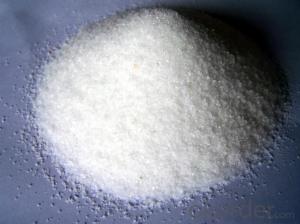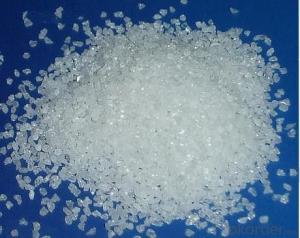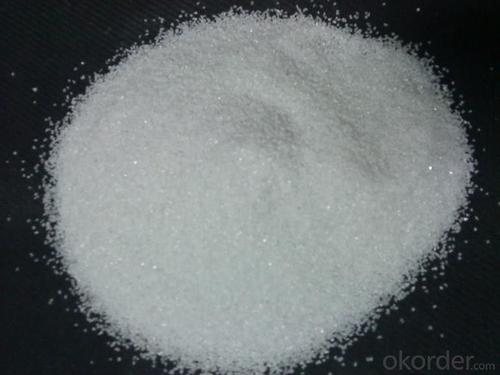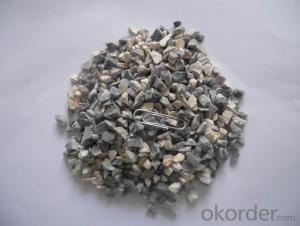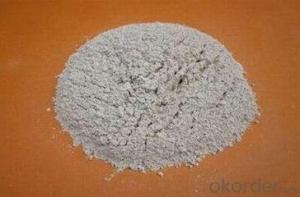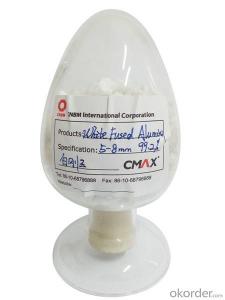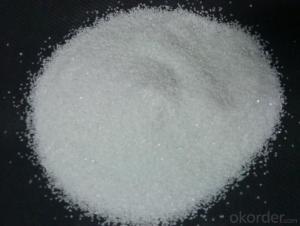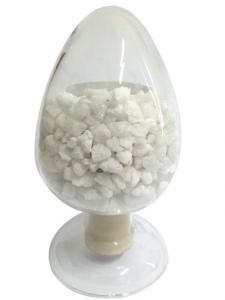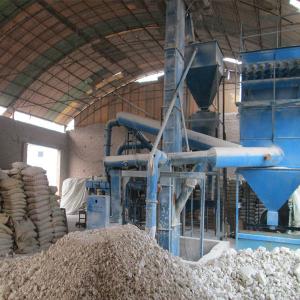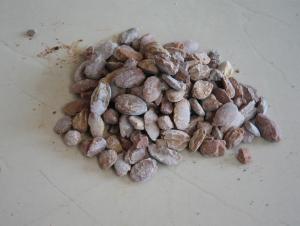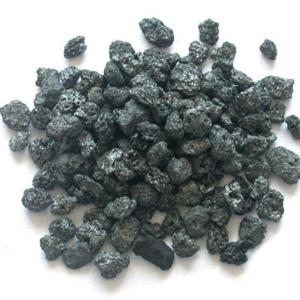Raw Materials for Refractory - White Fused Alumina WF98
- Loading Port:
- Tianjin
- Payment Terms:
- TT OR LC
- Min Order Qty:
- -
- Supply Capability:
- 1000MT m.t./month
OKorder Service Pledge
Quality Product, Order Online Tracking, Timely Delivery
OKorder Financial Service
Credit Rating, Credit Services, Credit Purchasing
You Might Also Like
Specification of white fused alumina
Item | B.D(g/cm3) | Apparent Porosity | Chemical Composition | |||
AL2O3 | Fe2O3 | SiO2 | NaO2 | |||
WFA | 3.7 | 7.8% | 99.2%min | 0.1%max | 0.2%max | 0.3%max |
Packaging & Shipping
In 1MT jumbo bag or as the buyer request.
We ship the cargo in 20' GP containers,each container loads 25MT/20bags.
Application of white fused alumina
1.Light-weight insulating refractories
2.Shaped and unshaped refractories
3.Pre-cast shapes and castables
4.High Alumina Refractory mixes and gunning mixes
- Q: How can refractory materials be divided?
- There are many criteria for the classification of refractories.Just referring to a book about refractory.
- Q: What's the fire?retardant material of roller shutter fire resistance door ?
- They are composited by inorganic materials, and the main components are perlite, inorganic adhesive and other special formula. It has flat and smoothe surface, unibody and stronger strength after molding. It has owned Chinese and Taiwan strength patent. It is fireproof, sound and thermal insulating. It has passed tests of Tianjin Fire Research Institute and Beijing construction institute. It is an ideal product.
- Q: whether the fire resistant level of aerated concrete building blocks can reach the grade one?
- the fire resistant level of aerated concrete building blocks can reach the grade one level. Aerated concrete strength grade shall be divided according to the concrete cubic compressive strength value. Use the symbol C and the cube compressive strength value (in N / mm2 or MPa gauge) to express. According to GB50010-2002 "concrete structure design specifications" provisions, ordinary concrete is divided into fourteen levels, namely: C15, C20, C25, C30, C35, C40, C45, C50, C55, C60, C65, C70, C75, C80 .
- Q: What kind of material is refractory fiber?
- Refractory fiber, also known as ceramic fiber, is a fibrous thermal insulation refractory. Refractory fiber, also known as ceramic fiber, is a fibrous thermal insulation refractory. It has the characteristics of ordinary fibers, such as softness, flexibility, having a certain tensile strength. And it can be further processed into a variety of products such as paper, wire, rope, tape, blankets and felts. Besides, it has high temperature resistance and corrosion resistance which ordinary fibers don't have. As a fire retardant and thermal insulated material, it has been widely used in metallurgy, chemical, machinery, building materials, shipbuilding, aviation, aerospace and other industrial sectors.
- Q: Who knows about the fire endurance of sintered shaly hollow bricks?
- Sintered shaly hollow bricks of Chu area have high intensity. The average compressive strength of them is up to 15.8, which matches with M7.5 cement mortar that has advantages of low water absorption, and good anti efflorescence performance. The fire endurance of sintered shaly hollow bricks should not exceed1050 degrees otherwise they will burn excessively. I, actually, think that the temperature should be controlled within 980 degrees. I hope my answer may help you.
- Q: what kind of fireproof materials is used for high rise buildings?
- Recommended thickness of 1mm or more # 304 stainless steel, refractory, corrosion-resistant, easy to clean. closed balcony of high rise buildings use thickened manganese, aluminum profiles. You can also use plastic steel window, solid wooden windows. Mg-Mn alloys have excellent weldability and corrosion resistance, unstressed corrosion tendency. Mechanical properties are not good enough, the ultimate strength of 210 ~ 280MPa.
- Q: How long is the fire endurance of the rock wool board?
- Hello. The limit is up to 2 hours. Of course such a thing is not desirable.
- Q: what's the detailed address of fireproof and thermal inuslation matertial market?
- following are the detailed address of fireproof and thermal inuslation matertial market: Central China Building decoration materials market,Hanxi 1 road No 95, Xinyongan Tangcai decoration material makert, Jianghan district Tangcai road No 53, Baoye decoration material wholesale market, Wuhan Wuchang district Minzhu road No 620.
- Q: What are the requirements for fire?rating of construction suspended ceiling material ?
- In fireproof design of all parts in interior decoration, fireproof design of suspended ceiling is the most important. Because the flame is burning up in fire and the suspended ceiling is the first and most direct part to test fire; at the same time, it has a direct impact on the evacuation. Therefore, in indoor suspended ceiling decoration design, fireproof work should be considered fully. Code of fire prevention design of interior decoratio of buildings has detailed provisions for fireproof?performance of indoor suspended ceiling materiial of different civil buildings. Suspended ceiling (sprung roof) refers to the top decoration of a house. Suspended ceiling, an important sub-project in construction decoration project, and the hidden layer of electrical equipment, ventilation and air condition, communication and fireproof, alarm pipelines, etc. has the functions of thermal insulation, sound insulation and absorption. Suspended ceiling plays an important role on the entire house decoration. Proper decoration to the house top surface, can not only beautify indoor environment, but also create a colorful interior artistic image. When choosing decoration materials and design of suspended ceiling, you should follow the principle of saving material, being solid, safe, beautiful and practical.
- Q: Are there any differences between insulation and refractory materials ?
- Refractory materials can resist more than 1200 degrees, some of which are not insulation materials, such as firebricks, which can directly contact with heat source, has little insulation effect. Ceramic fiber, high silica, etc. are all refractory materials which can insulate. Insulation materials with poor performance usually is lower than 800 degrees, which have large thermal resistance, and low thermal conductivity, high porosity. Thus they reduce the thermal loss. To put it simply, insulation materials store most of the heat and only let a small part of heat lose through the air, thus the heat has been isolated. Glass fiber, rock wool, flexible material for thermal insulation, etc.
Send your message to us
Raw Materials for Refractory - White Fused Alumina WF98
- Loading Port:
- Tianjin
- Payment Terms:
- TT OR LC
- Min Order Qty:
- -
- Supply Capability:
- 1000MT m.t./month
OKorder Service Pledge
Quality Product, Order Online Tracking, Timely Delivery
OKorder Financial Service
Credit Rating, Credit Services, Credit Purchasing
Similar products
Hot products
Hot Searches
Related keywords

